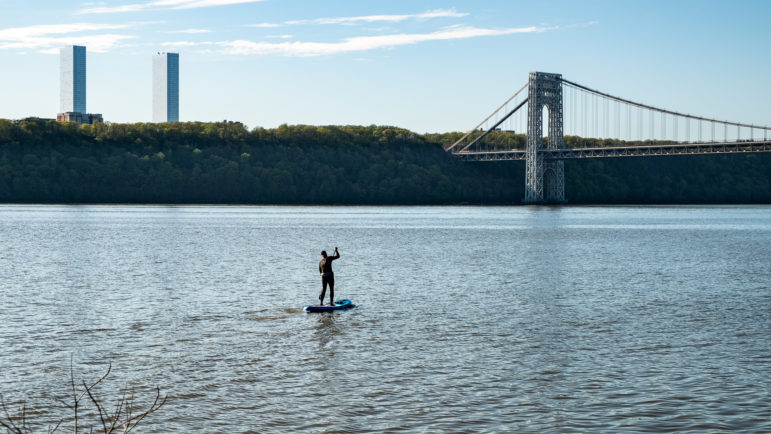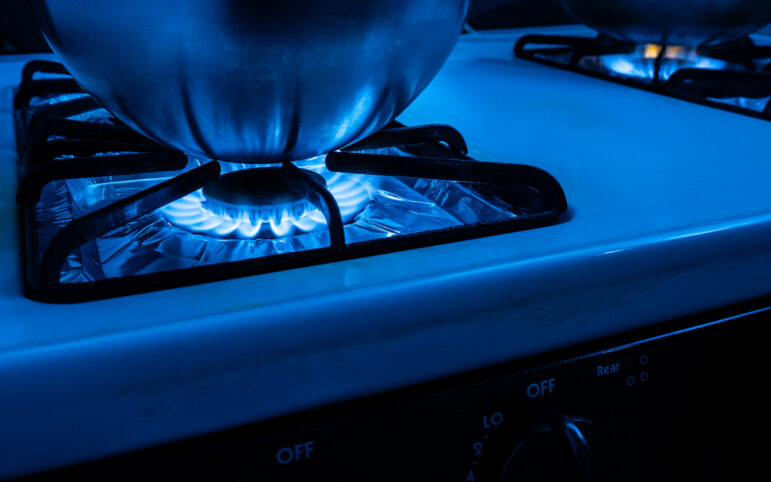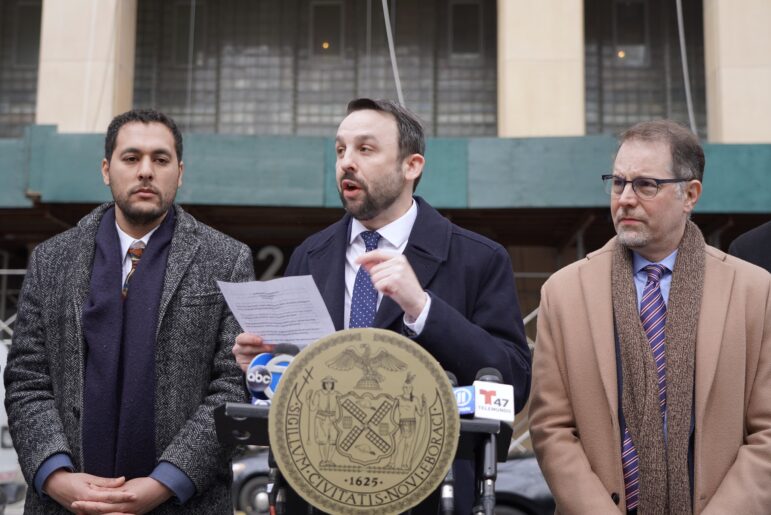
Adi Talwar
Person paddle boarding on the Hudson River during the early evening hours of May 5th.With a few clicks of the delete button, New York State this week made a significant change to how the federal Clean Water Act applies to the waters around New York City.
The change applies to two of the six designations for salt waterbodies in New York, and affects all or part of more than 20 waterways in the five boroughs, including Upper New York Bay, Raritan Bay, Fresh Creek, Paerdegat Basin, the Harlem River and the lower Bronx River.
Critics believe the change will undercut work to make local waters accessible to swimmers and anglers, which is the goal of the Clean Water Act.
For the city, now facing a fiscal crisis amid the COVID-19 pandemic, it could justify spending less to prevent raw sewage and tainted stormwater from flowing into New York’s rivers, creeks, bays and canals.
Regs for the dregs
In 2015, the state Department of Environmental Conservation (DEC) revised regulations covering Class SD and Class I waters.
Up to that point, the rules on Class SD waters had read: “The best usage of Class SD waters is fishing. These waters shall be suitable for fish, shellfish, and wildlife survival,” and the rules for Class I waters had stipulated, “The best usages of Class I waters are secondary contact recreation and fishing. These waters shall be suitable for fish, shellfish, and wildlife propagation and survival.”
The 2015 change added to both sets of rules the sentence: “In addition, the water quality shall be suitable for primary and secondary contact recreation, although other factors may limit the use for these purposes.”
The mention of “primary contact recreation” was significant. According to the Environmental Protection Agency (EPA) handbook on the Clean Water Act, primary contact means “swimming, water-skiing, skin-diving, surfing, and other activities likely to result in immersion.” Secondary contact refers to activities where immersion is unlikely, like boating, wading, and rowing.
Liquid litigation
DEC’s 2015 change, which New York City resisted, triggered a complex regulatory and legal wrestling match involving the EPA, the DEC, New York City’s Department of Environmental Protection and water-quality advocates. The dispute concerned New York City’s efforts, after decades of delay, to prevent sewer overflows from polluting city waters in violation of federal law.
In much of New York City, sewer lines and stormwater pipes join underground en route to water treatment plants. When it rains heavily, the combined volume of sewer and rain water can exceed the capacity of those plants, and so the excess is released directly into the waterways. The billions of gallons of untreated sewage released each year are a major reason why swimming and fishing are a bad idea in many city waters.
After decades of litigation, the city is wrapping up a set of plans to reduce sewer overflows and improve the health of waterways. Advocates say the city’s approach is too modest and would allow an unacceptably high volume of sewage release even after the plans are complete.
A central point of contention in the debate over what to do about sewage overflows is how the city gauges whether water is clean enough to pass federal standards. The city has tended to measure the amount of fecal coliform, a kind of bacteria. The EPA, however, has for years recommended that the city instead measure enterococci, a different bacteria that research suggests is more likely to indicate the presence of germs from human waste.
By designating city waterways as “primary contact,” the 2015 DEC order brought that scientific debate to a head, because it meant those waterways had to meet a higher standard.
So, a coalition of environmental groups including Riverkeeper, Save the Sound, Natural Resources Defense Council, Raritan Baykeeper and the Newtown Creek Alliance sued the EPA for failing to force the DEC—which oversees the Clean Water Act in New York—to impose updated testing standards on New York City.
With its action this week, the DEC might have short-circuited that legal battle.
A clarification or a retreat?
In October, DEC proposed revising the language on Class SD and Class I waters again—basically, to take out the sentences it added in 2015—so as “to clarify the intent.”
“Through this proposed rule making, NYSDEC is clarifying that the best usages of Class I and Class SD waters were, and remain, ‘secondary contact recreation and fishing’ and ‘fishing,’ respectively,” DEC said in a regulatory notice. “The proposed clarifications would impact limited waters in the state; the majority of I/SD waters are located in and around New York City (NYC), with a few waters located in and around Suffolk County.”
Advocates vigorously opposed the change.
“After making some progress toward stronger water quality standards over the last four years, why is DEC backtracking on the 2015 rule change and removing important protective language for these waterways?” asked Shino Tanikawa, a member of the steering committee for the Stormwater Infrastructure Matters (SWIM) Coalition. “Why is DEC now designating these waters as suitable for secondary contact only? We know from our members that many of these waters are already being used for human powered boating, fishing and even swimming.”
In spite of that opposition, the DEC finalized the change to its regulations on Tuesday.
It’s hard to say precisely what impact that will have on the lawsuit, on water quality or on the price-tag of pollution reduction efforts. The parties to the legal action wrote to the judge in the case this week to propose an expedited schedule for arguing whether or not the EPA was derelict in not forcing DEC to adopt higher standards.
In its public reporting about water quality in recent years, the city has applied the higher enterococci standard only to a few waterways, so it’s unclear how much cleaner the city’s waterways would have become had the EPA and DEC forced the city to bring them up to a swimmable standard.
As to what it means for the pricetag on pollution control projects, DEC said back in 2015 that the higher standard would not have created costs for New York City because the city was already obligated to clean up its water, but the city disputed that. All told, the city expects to spend $9.5 billion addressing sewage overflows—work that began in 1995 and will run to 2050.
For its part DEP, which supported the change to the regulations, said the move would not derail steady progress toward cleaner water around the five boroughs.
“New York Harbor is cleaner today than it has been in more than 150 years and with billions of dollars in upgrades planned primarily for the waterways that need the most improvement, we will see even healthier rivers, creeks and bays in the years ahead offering even more recreational opportunities,” Ted Timbers, a spokesman for the DEP, said in a statement.
Class I and Class SD Waters in New York City
Some waterways have a Class I section and a Class SD section; other waterbodies might have portions that do not fall under either class.
| Waterbody | Water Quality Class |
| Alley Creek/Little Neck Bay Tributaries | I |
| Arthur Kill (Class I) and minor tributaries | I/SD |
| Bergen Basin | I |
| Bronx River, Lower | I |
| Coney Island Creek | I |
| East River | I |
| Erie Basin | SD |
| Flushing Creek/Bay | I |
| Fresh Creek | I |
| Fresh Kills | SD |
| Gowanus Canal | SD |
| Harlem River | I |
| Hawtree Basin | I |
| Hendrix Creek | I |
| Hudson River | I |
| Kill Van Kull | SD |
| Lower New York Bay/Gravesend Bay | I |
| Minor Staten Island tributaries | I/SD |
| Minor Tidal tributaries to Jamaica Bay | I |
| Minor Tributries to Upper East River | I |
| Newark Bay | SD |
| Newtown Creek and tidal tributaries | SD |
| Paerdegat Basin | I |
| Raritan Bay | I |
| Sheepshead Bay | I |
| Shellbank Basin | I |
| Spring Creek and tributaries | I |
| Thurston Basin | I |
| Upper New York Bay | I |
| Westchester Creek | I |









3 thoughts on “Setback for Efforts to Make City Waters Swimmable”
Excellent reporting, thank you.
If the waters are not clean enough for primary contact what makes the fish caught in these waters edible?
Good question. Slightly different standards apply. Fish health generally relates to the amount of dissolved oxygen in the water. Human health is usually about the lack of fecal bacteria. It is possible for the former to be OK and the latter to still be a problem.